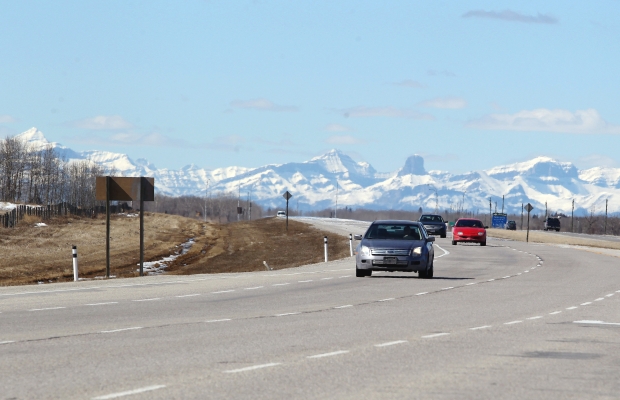The state of Alberta’s highways is getting worse — but Transportation Minister Ric McIver says it’s all part of the Tory government’s plan.

Whatever the strategy, the head of the organization representing small counties and municipal districts is warning that Alberta’s rural road system desperately needs more repair or the province risks losing some highways.
According to the Transportation Department’s new business plan, the percentage of provincial highway surfaces considered to be in good physical condition is expected to drop to 52 per cent by 2015-16 from 59 per cent in 2011-12.
In the same period, the amount of highway surface in poor condition is expected to increase to 18 per cent from 15 per cent, while the amount in fair condition will grow to 30 per cent from 27 per cent, says the plan, released as part of last month’s provincial budget.
In an interview, McIver said the government made a conscious decision to focus on building new infrastructure — such as ring roads in Calgary and Edmonton and twinning Highway 63 to Fort McMurray — rather than on road repair.
“It’s deliberate. And we’re well aware that we’re going to shift some of our emphasis in future years to a more heavy mix of rehabilitation and maintenance,” McIver said.

Get daily National news
The capital budget for highway rehabilitation — which includes paving and resurfacing — for this year is $134 million, just over $5 million more than what was spent in 2012-13.
But the amount is $104 million less than what the government spent in 2011-12, when the budget hit $238 million.
The maintenance capital budget, which encompasses areas such as signs, painting and barriers, dropped to $12 million in 2013 from $21 million last year.
Capital spending on new highway construction, ring roads, northern Alberta strategic projects and bridge construction will top $1.1 billion in 2013-14.
McIver insisted Alberta’s highways will still be among the best in Canada and driver safety won’t be affected. Priority for maintenance and rehabilitation will be given to highways with the heaviest traffic load.
But Bob Barss, president of the Alberta Association of Municipal Districts and Counties, said the Redford government needs to find more resources to go toward road repair, because there has already been a decline in the quality of the provincial highway system.
If the government takes away resources from secondary highways with lower traffic counts, there will be a further deterioration of those roadways. That, in turn, will move more drivers onto the municipally controlled rural road system, Barss said.
“If they don’t get this done in probably the next five to 10 years, they’re going to lose these highways and then they’re into hundreds and hundreds of millions to reconstruct and build them again, where putting another layer of asphalt on them will get 20 to 25 years of good service again,” he said.
“You can’t leave the (secondary) highways to fall apart.”
Wildrose MLA Drew Barnes said delaying road rehabilitation will only lead to greater costs in the future.
The Progressive Conservative government should redirect money from other areas to ensure there is enough cash for the upkeep of the roads, he said.
“It’s a government failing to prioritize where spending should be,” he said.
But Don Szarko, spokesman for the Alberta Motor Association, said he wasn’t concerned about the government’s projections about highway surface quality, as long as it ensures money is in place for repair over an extended period.
The government has “massively” invested in roads over the past several years, he noted.
“The one thing we are constantly advocating the government on is that we allocate sufficient funding to maintain the existing road network we have, because you don’t want to drop too far behind,” Szarko said.
“But there’s a reality, too. There’s kind of an ebb and flow. You can never be completely up to date on everything.”






Comments